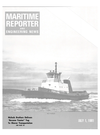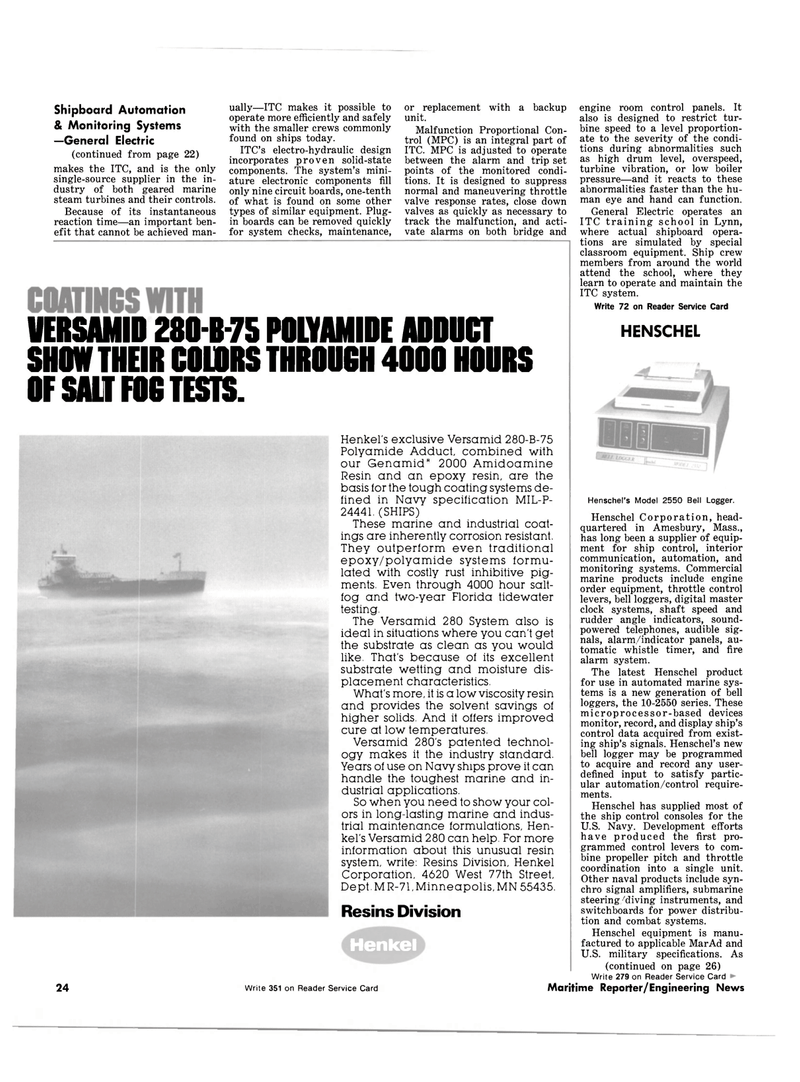
Page 22: of Maritime Reporter Magazine (July 1981)
Read this page in Pdf, Flash or Html5 edition of July 1981 Maritime Reporter Magazine
Shipboard Automation & Monitoring Systems —General Electric (continued from page 22) makes the ITC, and is the only single-source supplier in the in- dustry of both geared marine steam turbines and their controls.
Because of its instantaneous reaction time—an important ben- efit that cannot be achieved man- ually—ITC makes it possible to operate more efficiently and safely with the smaller crews commonly found on ships today.
ITC's electro-hydraulic design incorporates proven solid-state components. The system's mini- ature electronic components fill only nine circuit boards, one-tenth of what is found on some other types of similar equipment. Plug- in boards can be removed quickly for system checks, maintenance, or replacement with a backup unit.
Malfunction Proportional Con- trol (MPC) is an integral part of
ITC. MPC is adjusted to operate between the alarm and trip set points of the monitored condi- tions. It is designed to suppress normal and maneuvering throttle valve response rates, close down valves as quickly as necessary to track the malfunction, and acti- vate alarms on both bridge and
VERSJUIID 280-B-75 POIYAMIDE ADDUCT
SHOW THEIR COLORS THROUGH 4000 HOURS
OF SAL! FOG TESTS.
Henkel's exclusive Versamid 280-B-75
Polyamide Adduct, combined with our Genamid" 2000 Amidoamine
Resin and an epoxy resin, are the basis tor the tough coating systems de- fined in Navy specification MIL-P- 24441. (SHIPS)
These marine and industrial coat- ings are inherently corrosion resistant.
They outperform even traditional epoxy/polyamide systems formu- lated with costly rust inhibitive pig- ments. Even through 4000 hour salt- fog and two-year Florida tidewater testing.
The Versamid 280 System also is ideal in situations where you can't get the substrate as clean as you would like. That's because of its excellent substrate wetting and moisture dis- placement characteristics.
What's more, it is a low viscosity resin and provides the solvent savings of higher solids. And it offers improved cure at low temperatures,
Versamid 280's patented technol- ogy makes it the industry standard.
Years of use on Navy ships prove it can handle the toughest marine and in- dustrial applications.
So when you need to show your col- ors in long-lasting marine and indus- trial maintenance formulations, Hen- kel's Versamid 280 can help. For more information about this unusual resin system, write: Resins Division, Henkel
Corporation, 4620 West 77th Street,
Dept. MR-71, Minneapolis, MN 55435.
Resins Division
Henkel engine room control panels. It also is designed to restrict tur- bine speed to a level proportion- ate to the severity of the condi- tions during abnormalities such as high drum level, overspeed, turbine vibration, or low boiler pressure—and it reacts to these abnormalities faster than the hu- man eye and hand can function.
General Electric operates an
ITC training school in Lynn, where actual shipboard opera- tions are simulated by special classroom equipment. Ship crew members from around the world attend the school, where they learn to operate and maintain the
ITC system.
Write 72 on Reader Service Card
HENSCHEL 24 Write 351 on Reader Service Card
Henschel's Model 2550 Bell Logger.
Henschel Corporation, head- quartered in Amesbury, Mass., has long been a supplier of equip- ment for ship control, interior communication, automation, and monitoring systems. Commercial marine products include engine order equipment, throttle control levers, bell loggers, digital master clock systems, shaft speed and rudder angle indicators, sound- powered telephones, audible sig- nals, alarm/indicator panels, au- tomatic whistle timer, and fire alarm system.
The latest Henschel product for use in automated marine sys- tems is a new generation of bell loggers, the 10-2550 series. These microprocessor-based devices monitor, record, and display ship's control data acquired from exist- ing ship's signals. Henschel's new bell logger may be programmed to acquire and record any user- defined input to satisfy partic- ular automation/control require- ments.
Henschel has supplied most of the ship control consoles for the
U.S. Navy. Development efforts have produced the first pro- grammed control levers to com- bine propeller pitch and throttle coordination into a single unit.
Other naval products include syn- chro signal amplifiers, submarine steering giving instruments, and switchboards for power distribu- tion and combat systems.
Henschel equipment is manu- factured to applicable MarAd and
U.S. military specifications. As (continued on page 26)
Write 279 on Reader Service Card
Maritime Reporter/Engineering News

 21
21

 23
23
